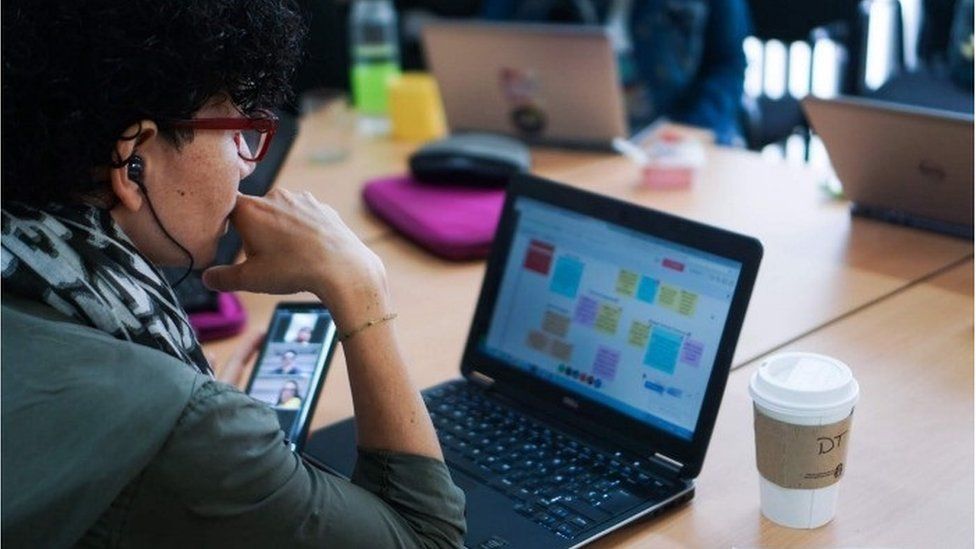The tech promising to bring lectures alive
For Jennifer Kasiama, a student at Toronto’s Ontario College of Art and Design, 2020 was an incredibly frustrating year.
Like so many others, her course become all-virtual when the pandemic took hold. «I spent so much time on my laptop, I definitely got Zoom fatigue,» says Ms Kasiama, 20.
«My attention wasn’t as focused as I’ve been with in-person classrooms, and my grades definitely suffered in the first semester.»
After struggling in the autumn she began to monitor her screen habits, while also managing her time more successfully. In the second term her grades inched up.
The lurch into virtual learning has been jarring for both students and educators.
«The transition was so unbelievable, I practically got whiplash from it,» says Steven Miller, a professor of journalism and media studies at Rutgers University in New Jersey.

He was used to teaching his journalism students about reacting to a crisis, but also found himself struggling to manage the sudden shift to virtual courses as the pandemic forced Rutgers and colleges across the world to lock down.
First, he noticed a gap in communication between educators and students. «In teaching you want to see your students faces to find out if they understand what is being presented to them, and when we went to online learning, students weren’t obligated to turn on their cameras,» Prof Miller says.
Then, he had to quickly adapt to new software his school asked teachers to use for synchronous (real-time) and asynchronous (pre-recorded videos students can access anytime) learning. He recorded lectures using Canvas, which helps deliver online video to students, similar to Zoom.
So what does the future hold? It seems likely that for many colleges there will be a hybrid format of online and in-classroom learning.
Tech firm Top Hat is hoping to cash-in on that.
The Toronto-based firm offers a digital courseware platform that lets anyone running a course film lectures, grade assignments, add live chat and discussion boards, and launch custom quizzes.
The popularity of its system surged during the pandemic. Top Hat recorded a 66% growth in revenue growth in the year to March 2021 – half of its current users have joined since the pandemic began.

«What drove this uptick in demand is how educators needed to maintain that engagement with their students – it’s something we even saw pre-pandemic, for those in distance-learning programmes,» says Nick Stein, chief marketing officer at Top Hat.
It’s not enough to just move everything to a virtual space, though. Post-secondary students didn’t feel as motivated by their courses when online classrooms became the norm.
A study found half of US students said they were very satisfied with their courses before they went fully online, but that figure fell to 19% when their courses shifted online.
The software can only do so much, Mr Stein says. Educators still have to maintain some of the routines they practised pre-remote learning, such as arriving 10 minutes before the class begins to chat with students.
Between April 2020 and March 2021, educational workspaces grew by 492% and, in general, monthly active members and guests grew by 359%.
The software simplifies how teachers can add quizzes to courses, for example, or use a course template that another educator using the service has designed and made public.

«I think we all realized soon after the lockdowns began we can’t handle six hours straight of Zoom,» says Marianno Suarez-Battan, co-founder and chief executive of Mural.
«We can unbundle that for students, say, and bring more interactivity and flexibility to classrooms using features such as breakout rooms.»
So-called breakout rooms are a common feature on Zoom, which Ilona Posner gladly used when teachings students at the University of Toronto’s computer science department. «Large classes don’t offer individual attention but they can group together in those breakout rooms,» she says.
What helped her in 2020, and what she will continue to monitor this year, is the cognitive load her students have to deal with in a virtual classroom.
«I try very hard to minimize all that switching from Zoom to slides then to Canvas then to Mural. That can disengage students from the class.»

When the right interactive tools are used to keep the interest of students, it can be a win-win for both sides: Designing effective learning environments and embedding online technologies «can serve as catalysts for teachers to experiment new things, explore creative alternatives and reflect on their own practices,» a European research report found in July 2020.
What all players in the virtual classroom sector should also be cheering on is the acceptance of online credentials among senior managers.
According to a survey that will soon be released by Northeastern University, the perception of quality for qualifications earned online has been growing steadily, says Sean Gallagher, executive director of its future of higher education centre.
«It appears that the remote schooling and working experiences of the pandemic have helped shed some of the scepticism and stigma that surrounded online learning for some in the past,» Mr Gallagher adds.
Yet for some students, online learning is never going to be enough.
Jennifer Kasiama is not sure she will return to her course if it becomes online only, saying she might take a year out.
«I miss going into the city for school and I miss being with my fellow students in-person, not just on Zoom. I don’t think online school is right for me.»
Fuente de la Información: https://www.bbc.com/news/business-57226744







 Users Today : 210
Users Today : 210 Total Users : 35459805
Total Users : 35459805 Views Today : 372
Views Today : 372 Total views : 3418344
Total views : 3418344